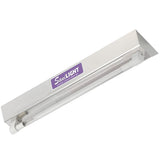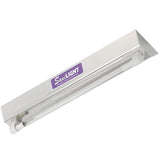What's the Difference Between Fluorescent and Germicidal Light?
Posted by Dave on for ProLampSales

Most germicidal bulbs look like linear fluorescent light bulbs. They have the same shape. They share similar base types. Both use low pressure mercury arc technology. They both have hot cathode and cold cathode lamp types. They both use external ballasts to regulate voltage between the building and the lamp. And both produce the same ultraviolet radiation inside the bulb.
However, germicidal light bulbs can't usually be purchased in general home improvement stores, where fluorescent bulbs are easily found. And those linear fluorescent tubes are sold by the case and can be found by the dozens in just one room, while germicidal lamps are usually sold one-off for a much higher price and you almost never see them, other than through specialty online outlets.
So what's the difference?
Germicidal UVC
The fluorescent bulb is coated on the inside with one or multiple phosphors which convert the ultraviolet light produced inside the lamp to visible light or other types of ultraviolet radiation. The germicidal bulb is clear and it is made of special glass which transmits the ultraviolet, primarily 253.7 nanometer wavelength radiation generated by the arc. Ozone-producing UV bulbs are made of a different type of quartz glass that allows the 185nm wavelength to transmit through the bulb envelope.
There are several types of glass used in germicidal bulbs depending on what wavelengths are required. For example, one type of glass bulb will block ozone producing radiation and another will allow it. Another type will allow a lesser amount of the ozone-producing wavelength to pass.
Because the glass of germicidal bulbs is clear and designed to allow powerful ultraviolet radiation to pass through it, users of these bulbs must be much more careful to avoid looking directly at them compared to fluorescent bulbs which block most of the UV.
Other UV Spectrums
For UVA and UVB applications, special phosphors are used to coat the inside of the bulb. These are very different phosphors from the ones used to create visible light, but they are not clear bulbs like UVC lamps. UVA Blacklights can emit UV radiation around 350nm or 365nm. UVB bulbs emit radiation around 308nm. They often appear similar to regular fluorescent tubes, as the phosphors are white in appearance. But the emission spectrum is quite different from visible light tubes.
Visible Light
As mentioned above, fluorescent tubes use the same technology to create ultraviolet radiation as the UVC bulbs, but they use different phosphors to convert that UV radiation to visible light. The phosphors absorb the UV, making them safe, and emit visible light. Depending on the phosphors used, color temperature and even color rendering can be fairly tightly controlled by lighting manufacturers. This makes fluorescent lights (linear and compact CFL) extremely versatile.
Applications
The applications each type of bulb is used in also differ. Fluorescent tubes and compact fluorescent lamps can be found in all types of ceiling and fixtures in residential and commercial buildings. CFL bulbs were one of the first replacements for traditional incandescent and halogen lighting in homes, although they never caught on the to extent that LED has. Troffers with several linear fluorescent bulbs each are still installed by the millions in commercial buildings and offices throughout the world.
Germicidal bulbs are only found in very specialized ultraviolet fixtures, and the bulbs are typically shielded from view inside of the machine. UV-C germicidal light can be used for water purification in municipal, marine, aquarium, and commercial applications, while air disinfection systems are used in hospitals and medical clinics. In most cases, though, you'll never see the light emitted by the germicidal lamps, as it is dangerous to humans and animals, which is why it is used in the first place to deactivate harmful microorganisms.
Featured Products (View All)
- 1 comment
- Posted in Fluorescent, Ultraviolet Light
1 comment





Can you make a germicidal fluorescent tube LED type so that no ballast needed